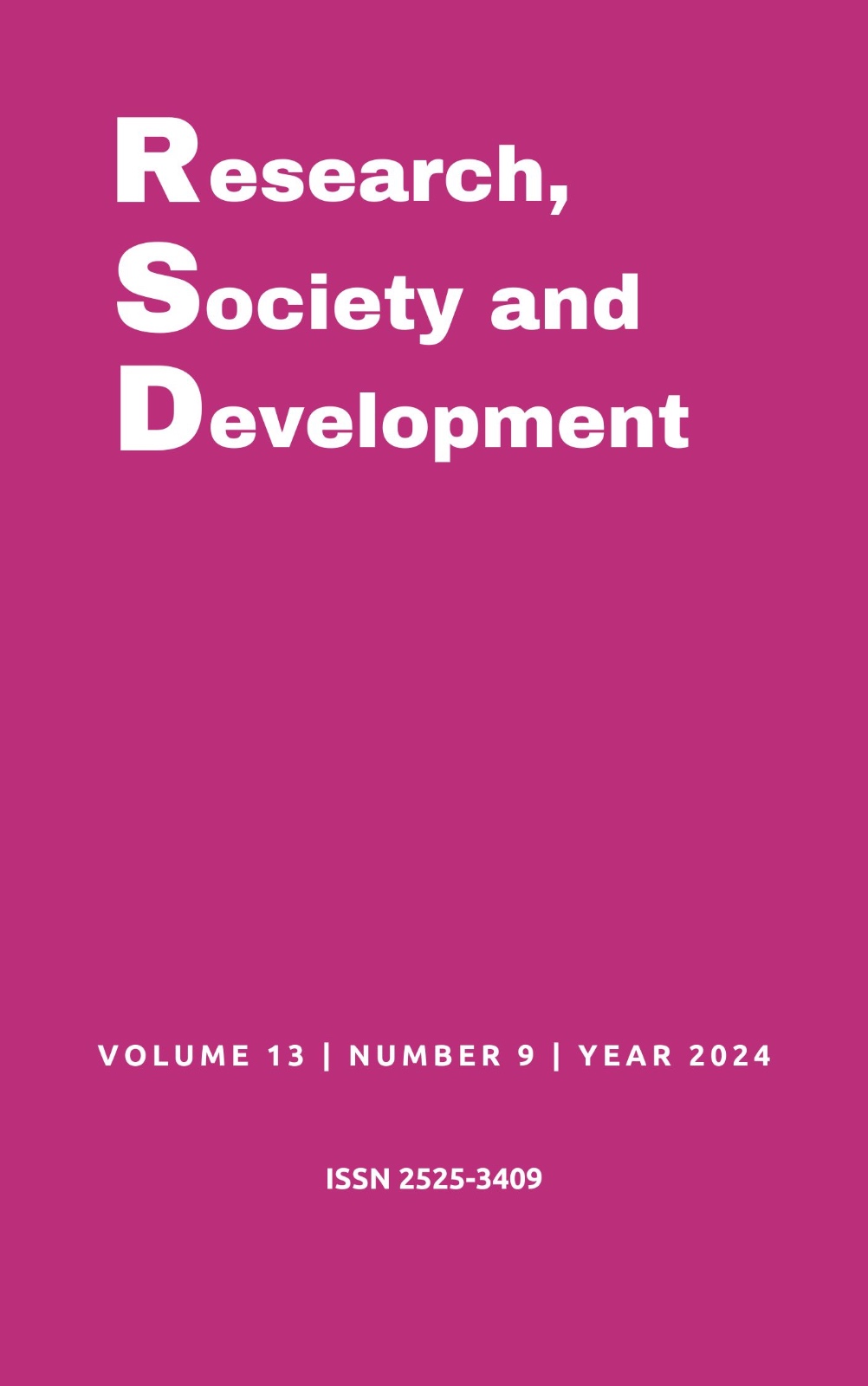Challenges and possibilities of teaching Genetics in Science classes: Learning heredity in a dynamic way
DOI:
https://doi.org/10.33448/rsd-v13i9.46778Keywords:
Heredity, Genetics, Teaching-learning, Active methodologies.Abstract
The use of innovative pedagogical tools that enable meaningful learning are very important in teaching practice. Thus, this qualitative research aimed to evaluate the use of the Interactive Didactic Sequence (IDS) in learning about the concept of heredity in a 9th grade class at a public school in Santana do Ipanema, Alagoas. This methodology was applied in 2021, in a classroom with 15 students, using two consecutive 50-minute classes. The IDS follows three basic steps: (I) individual concept; (II) group concept; (III) general synthesis concept. After applying the methodology, we can conclude that the concept formulated by the students is close to the scientific concept, confirming that the interaction between them resulted in good learning of the concept worked on. Finally, we show that the IDS is an important methodological tool for teaching, as it encourages the student's protagonism in the construction of knowledge, where their experiences inside and outside the school are considered. Furthermore, we highlight that the work was carried out in a pandemic scenario, which resulted in educational changes, such as smaller classes, which may have facilitated the application of IDS. However, we emphasize that IDS is an indispensable methodology, being validated by several authors in the educational field.
References
Alagoas. (2021a). PORTARIA/SEDUC No 13.361/2021. Diário Oficial de Alagoas. http://www.educacao.al.gov.br/aviso/item/17854-por
Alagoas. (2021b). PORTARIA/SEDUC No 9. Diário Oficial Estado de Alagoas. http://www.educacao.al.gov.br/aviso/item/17666-portaria-seduc-9-975-2021-institui-o-retorno-as-aulas-presenciais-na-rede-estadual-de-ensino-do-estado-de-alagoas
Borges, C. K. G. D., Silva, C. C. da, & Reis, A. R. H. (2017). As dificuldades e os desafios sobre a aprendizagem das leis de mendel enfrentados por alunos do ensino médio Difficulties and challenges on learning Mendel laws for high school students. Revista Experiências em Ensino de Ciências, 12(6).
Cezana, N. A. O., & Silva, M. (2022). Utilização de uma sequência didática com metodologias ativas como proposta para o ensino de genética. Research, Society and Development, 11(15), e563111537385. https://doi.org/10.33448/rsd-v11i15.37385
Freire, P. (2004). Pedagogia da autonomia: saberes necessários à prática educativa. Paz e Terra.
Lavor, O. P., & Oliveira, E. A. G. (2022). Sequência didática interativa na discussão do conceito de energia. REAMEC - Rede Amazônica de Educação Em Ciências e Matemática, 10(1). https://doi.org/10.26571/reamec.v10i1.13122
Marques, H. R., Campos, A. C., Andrade, D. M., & Zambalde, A. L. (2021). Inovação no ensino: uma revisão sistemática das metodologias ativas de ensino-aprendizagem. Avaliação: Revista Da Avaliação Da Educação Superior (Campinas), 26(3), 718–741. https://doi.org/10.1590/s1414-40772021000300005
Monteiro, J. C., Castilho, W. S., & Souza, W. A. de. (2019). Sequência Didática Como Instrumento De Promoção Da. Revista Eletrônica DECT, 9(1), 292–305.
Nicola, J. A., & Paniz, C. M. (2016). A importância da utilização de diferentes recursos didáticos no ensino de ciências e biologia. Revista Do Núcleo de Educação a Distância Da Unesp.
Nova, J. S. V., & Firme, R. do N. (2022). Analisando a sequência didática interativa no processo de construção/reconstrução de concepções de licenciandos em Química sobre a natureza da Ciência. Dialogia, 41, e20487–e20487. https://doi.org/10.5585/41.2022.20487
Oliveira, M. M. de. (2013). Sequencia didatica interativa no processo de formacao de professores. Editora Vozes. https://books.google.com/books/about/Sequência_didática_interativa_no_proce.html?hl=pt-BR&id=auQbBAAAQBAJ
Oliveira, J. B. A. e, Gomes, M., & Barcellos, T. (2020). A Covid-19 e a volta às aulas: ouvindo as evidências. Ensaio: Avaliação e Políticas Públicas Em Educação, 28(108), 555–578. https://doi.org/10.1590/s0104-40362020002802885
Pais, H. M. V., Silva, R. C. de S., Souza, S. M. de, Ferreira, A. R. O., & Machado, M. F. (2019). A contribuição da ludicidade no ensino de ciências para o ensino fundamental / The contribution of playfulness in teaching science to elementary education. Brazilian Journal of Development, 5(2), 1024–1035. https://doi.org/10.34117/BJDV5N2-1071
Piffero, E., Soares, R., Coelho, C., & Roehrs, R. (2020). Metodologias Ativas e o ensino de Biologia: desafios e possibilidades no novo Ensino Médio. Revista Ensino & Pesquisa, 18(2), 48–63. https://doi.org/10.33871/23594381.2020.18.2.48-63
Santos, C. D. J. S., Brasileiro, S. G. dos S., Maciel, C. M. L. A., & Souza, R. D. de. (2015). Ensino de Ciências: Novas abordagens metodológicas para o ensino fundamental. Revista Monografias Ambientais, 14, 217–227. https://doi.org/10.5902/2236130820458
Santos, D. F. A. dos, & Castaman, A. S. (2022). Metodologias ativas: uma breve apresentação conceitual e de seus métodos. Revista Linhas, 23(51), 334–357. https://doi.org/10.5965/1984723823512022334
Santos, F. S. dos, Ferraz, D. F., Klein, Â. I., Francisco, A. C. de, & Miquelin, A. F. (2020). Sequência didática fundamentada na neurociência para o ensino de genética. Revista Electrónica de Enseñanza de Las Ciencia, 19(2).
Silva, M. J. J. S., Dias, G. A., & Anecleto, Ú. C. (2021). Gênero meme e formação do hiperleitor por meio da sequência didática interativa. Revista Docência e Cibercultura, 5(1), 117–137. https://doi.org/10.12957/redoc.2021.53029
Ugalde, M. C. P., & Roweder, C. (2020). Sequência didática: uma proposta metodológica de ensino-aprendizagem. Revista de Estudos e Pesquisas Sobre Ensino Tecnológico (EDUCITEC), 6, e099220. https://doi.org/10.31417/educitec.v6ied.especial.992
Ventura, S. S. (2019). A hereditariedade para Manoel Bomfim. Revista Do Instituto Histórico e Geográfico de Sergipe, 1(49), 97–110. https://periodicos.ufs.br/rihgse/article/view/11922
Downloads
Published
Issue
Section
License
Copyright (c) 2024 Emanuela Farias da Silva; Edlene da Silva dos Santos; Karolynne Rodrigues Gonçalves; Jarielson Silva Acioli; Leticia Pereira Bezerra

This work is licensed under a Creative Commons Attribution 4.0 International License.
Authors who publish with this journal agree to the following terms:
1) Authors retain copyright and grant the journal right of first publication with the work simultaneously licensed under a Creative Commons Attribution License that allows others to share the work with an acknowledgement of the work's authorship and initial publication in this journal.
2) Authors are able to enter into separate, additional contractual arrangements for the non-exclusive distribution of the journal's published version of the work (e.g., post it to an institutional repository or publish it in a book), with an acknowledgement of its initial publication in this journal.
3) Authors are permitted and encouraged to post their work online (e.g., in institutional repositories or on their website) prior to and during the submission process, as it can lead to productive exchanges, as well as earlier and greater citation of published work.


